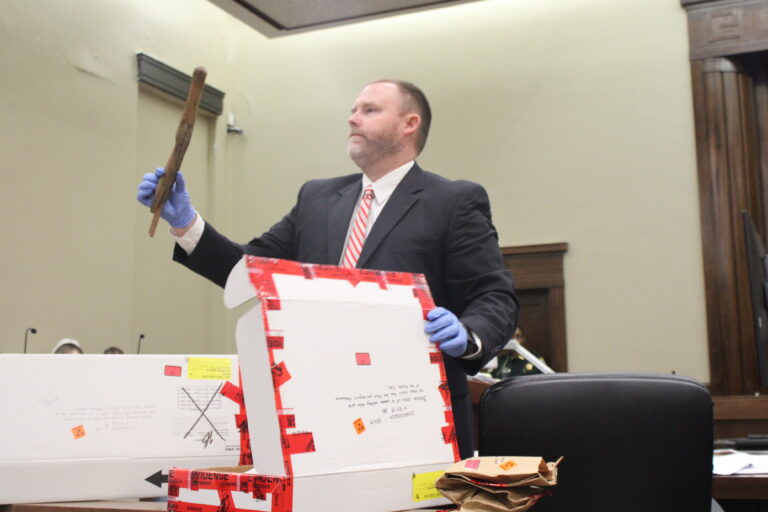Legacy Post Disclaimer
This is a #Legacy post imported from The Apalachicola Time’s previous platform. If you’re experiencing issues with this article, please email us at news@nevespublishing.com.
A lens comes home
Hidden inside of the Crooked River Lighthouse museum is a rare and exquisite piece of glass, soon to be unveiled for the entire county, region and world to see.
It’s the original lens from the lighthouse, dating back more than a century, and for the last 45 years stored in New Orleans on the 11th floor of the US Coast Guard district office there.
“It was hidden away and nobody saw it,” said Steve Allen, president of the Carrabelle Lighthouse Association.
But it is hidden no more, and soon it may even be on display, together with the original oil lamp, even rotating.
Here’s what happened, back to when the lighthouse began operations on Oct. 28, 1895, and the Fresnel (pronounced fray-NEL) lens directed its beacon from atop the 100-foot tall skeletal steel tower. The beacon guided mariners through the East Pass between Dog Island and St. George Island and safe passage to the Carrabelle river. The 4th order lens remained in operation until it was removed from service by the Coast Guard in 1976 and replaced with a modern optic.
The bi-valve one-third open 4th order lens held a unique arrangement of glass prism rings mounted on a brass framework, said to be the first of its type to be installed in the US. The unique lens was fabricated by the Henri LePaute Company in Paris, in 1894, by a French clock maker who began designing and manufacturing Fresnel lenses in the early 1800s.
In 1976, the Coast Guard began removing Fresnel lenses due to leakage of the toxic mercury used as a lubricant to provide frictionless rotation of the heavy iron, brass and glass lenses. Without an effective non-toxic replacement, the lenses were removed from service, gathered from various lighthouses and stored without records of their original location.
But unlike most of the randomly warehoused decommissioned optics, Crooked River’s bi-valve lens ended up in a small collection of lenses housed at the US Coast Guard District 8 Headquarters in New Orleans.
“That’s what’s unique about it,” said Allen. “Most lenses in 1975 got warehoused in Washington and lost their provenance. We’re one of only a few that knew where the original lens was.”
In February, the lens, now 125 years old, made its way back home to Carrabelle, and was installed in the Keeper’s House museum. An exhibit is under design and construction to fully reveal its splendor and historic fortune. This lens will be formally unveiled to the public when the exhibit is complete.
The Carrabelle Lighthouse Association, a nonprofit that began in 1999, was instrumental in the preservation and restoration of the deteriorating and decommissioned Crooked River Lighthouse tower. In Dec. 2007, the lighthouse was relit as a private aid to navigation by an acrylic replica of the lens, and still casts its beam as far as 17 miles out into the gulf.
Twenty years ago, after the association identified the location of the historic lens, years of informal discussions and formal requests led to the Coast Guard agreeing to a long-term loan in 2019.
“We had been petitioning the Coast Guard to have the lens returned,” Allen said. “They said it would be bad for morale. We pointed out it would be good for our morale if it was home.”
In early 2020, the association hired an expert lampist, a lens specialist who is authorized to safely transport these historic artifacts. John Canetta, a lighthouse historian, traveled to New Orleans to help the lampist pack up and move the original lens. A light restoration and cleaning of the lens was accomplished once the lens was secure in the keeper’s museum exhibit location.
This article originally appeared on The Apalachicola Times: A lens comes home




Meet the Editor
David Adlerstein, The Apalachicola Times’ digital editor, started with the news outlet in January 2002 as a reporter.
Prior to then, David Adlerstein began as a newspaperman with a small Boston weekly, after graduating magna cum laude from Brandeis University in Waltham, Massachusetts. He later edited the weekly Bellville Times, and as business reporter for the daily Marion Star, both not far from his hometown of Columbus, Ohio.
In 1995, he moved to South Florida, and worked as a business reporter and editor of Medical Business newspaper. In Jan. 2002, he began with the Apalachicola Times, first as reporter and later as editor, and in Oct. 2020, also began editing the Port St. Joe Star.